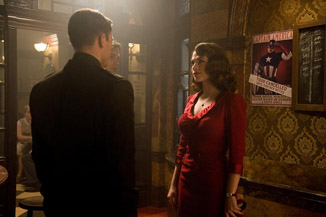(Comic) Book vs. Movie
Captain America
By Russ Bickerstaff
July 28, 2011
In this corner: the Comic Book. Sequential pieces of artwork assembled into a narrative order in the interest of telling a story. This kid started his career re-packaging old newspaper comic strips. Nearly a century later, he has gone from being a scrawny venue for children’s fare to being a well-respected heavyweight art form in various circles. One such circle is Hollywood, where his material has become a reasonably reliable source of profitable ideas.
And in this corner: the Movie. A 112-year-old kid born in France to a guy named Lumiere and raised primarily in Hollywood by his uncle Charlie "the Tramp" Chaplin. This young upstart has quickly made a huge impact on society, rapidly becoming the most financially lucrative form of storytelling in the modern world.
Both square off in the ring again as Box Office Prophets presents another round of (Comic) Book vs. Movie.
Captain America
Joe Simon was a successful commercial artist just seven years out of high school when Germany invaded Poland in 1939. At the time, he had been successful enough to land a job as editor for a comic book company named Timely Comics. There was debate at the time whether or not it was a good idea for the US to enter a growing war in Europe. Simon was solidly on the side of US involvement, creating a patriotic hero named Captain America to promote the idea. His publisher Martin Goodman must’ve been sympathetic because he’d green-lit a comic book exclusively for the character. (Starting off a character in his or her own book generally didn’t happen back then.) Goodman wanted Captain America Comics to hit the stands as soon as possible.
Essentially a 20-page political cartoon supporting US involvement in the war, the first issue of Captain America Comics went on sale about one year prior to the bombing of Pearl Harbor. Released in December of 1940, the debut issue sold nearly one million copies. With an image of Captain America socking Hitler on the jaw, the issue prompted quite a bit of hate mail from those who opposed US involvement in the war. (The issue had a cover date of, “March, 1941,” but the practice of post-dating a comic book cover in the interest of keeping it on the magazine stands longer is a long and distinguished one that goes back many, many years.)
Captain America Comics promptly became very successful, regularly selling somewhere around one million copies per issue. (It routinely outsold Time magazine.) Simon and his collaborator Jack Kirby left the series and its publisher for a more financially lucrative career at the company that was to become DC comics, but they left behind the first ten issues of a comic book featuring a character who is still quite popular today.
Over 70 years after the character debuted, he is the subject of a major film being released by Paramount pictures. Captain America is a character that first debuted when the US was about to enter a major war in Europe. He is now the subject of a big-budget film being released in an era where popular sentiment is growing against US military involvement beyond Europe. How do those first ten issues of the wildly successful comic book of the 1940s compare with a contemporary big-budget film inspired by them?
Continued:
1
2
3
4
5
6




